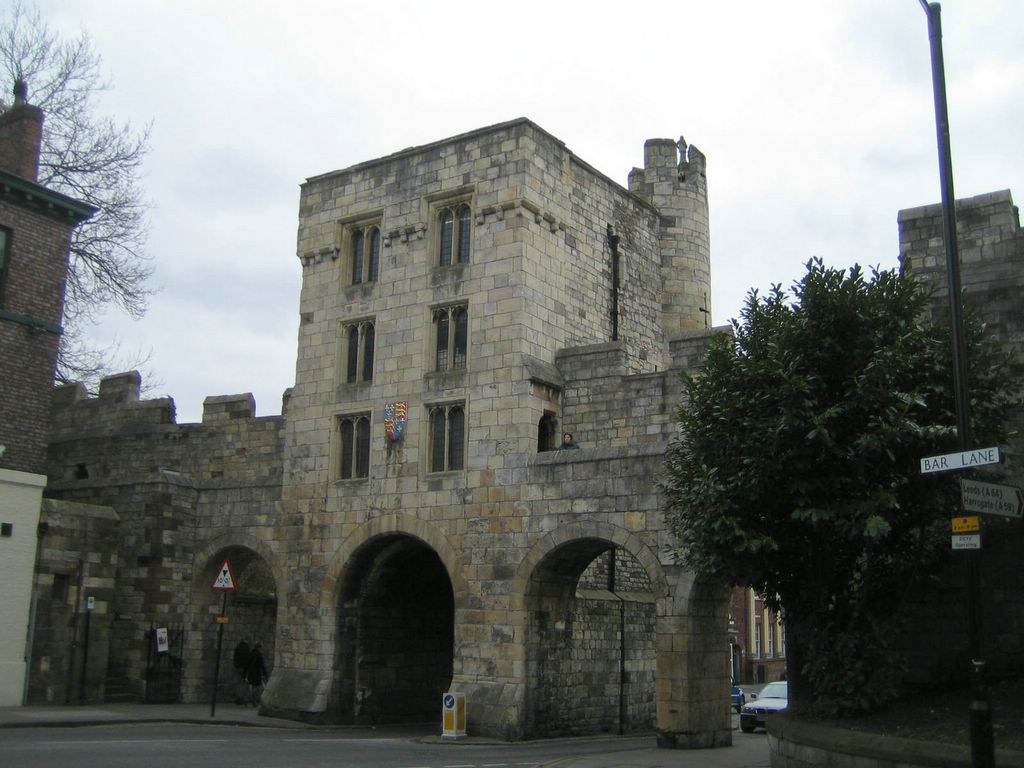Mickelgate Bar
Visited
19 March 2006
"Off with his head and set it on York's
gates; so York may overlook the Town of York
Not
from Alice in Wonderland but instead Shakespeare's Queen
Margaret ferklempt with the Duke Of York in Henry VI, Part
3
By now, we've proceeded clockwise over about 2/3rds of the
York walls since our start at Bootham Bar.
Below is the four-story Mickelgate Bar, so named from the
Viking word for great or much (mykla) and
street (gate). This is perhaps the most famous of
York's gates as it was the entrance you'd use if you came on
the road from London. Depending upon your station in
life, you would be greeted well or part of the greeting: If
you were king, then a lot of decoration and pomp would be
lavished on you. However, you'd still have to stop at
Mickelgate Bar and ask
permission of the mayor to enter. (Today for we
commoners, a Visa or American Express cards hidden in a
pocket gets us in unchallenged). In days of old,
if the king wanted to encourage behavior modification, he'd
have you decapitated and your head placed on a long stick
here for a while to feed the birds. (He'd also likely
have you drawn and quartered with body parts generously
distributed to the other bars, but before the days of
forensic DNA, the head would be a better reminder to
passers-through as to who was being so dishonored.)
Future lawyers today have it easier when they fail to pass
the bar.
War is no rose garden: Probably the
most famous head displayed here was that of home-town
boy and king-wannabe
Richard Plantagenet, 3rd Duke of York (father of
that Richard III guy who died 25 years later).
Plantagenet's son, Edward IV, rescued it three months
later, replacing it with four Lancastrian
heads. Obviously, he was trying to
bring the War of the Roses which Richard of York had
started to a head. (Richard III -- Richard
Plantagenet's other son -- would finish it by giving up
his head later). While never king, Richard won
the DNA battle: All monarchs of England since
1603 trace their lineage through his granddaughter,
Elizabeth of York, (who, incidentally, is the queen
whose picture is on
playing cards). She accomplished this by
marrying the family's nemesis, Henry VII and bearing 7
or 8 children (who can count that high), including
Henry VIII.
|
 |
Mickelgate Bar replaced a wooden gate in the 12th
century. (Note the
Norman arch still somewhat in the dark ages in the photo
below). During the 14th century, the upper stories were
added to house a portcullis. Big on recycling, Yorkers
used leftover Roman stone including a
few coffins. A barbican was also added then but
removed in the 19th century as were those of all but one of
the other York bars.
Look closely in the picture to see Jane of Houston, head
intact, on the second story; this gives you an idea of how
vacant the walls are in mid March, even on a sunny day.
Apparently, the two million other annual visitors stayed
away. Probably they wanted the birthday girl to have
the walls to herself.
Lost? If so,
click here for a good map of the York Walls (in PDF
format)
For more narrative on York, see our description web page by clicking here.



